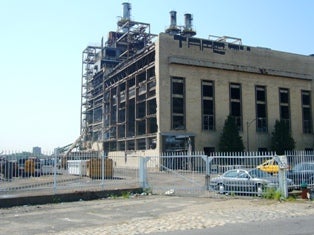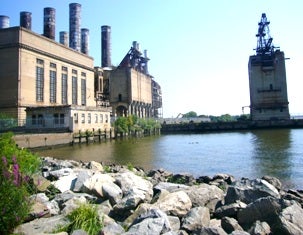Demolition at Delaware Power Plant

Delaware power plant / photos courtesy of Hilary Regan
Aug. 21, 2009
By Steven B. Ujifusa
For PlanPhilly
Every time she drives past it, Shanta Schachter of the New Kensington Community Development Corporation marvels at the PECO Delaware Power Station.
Since 1917, its massive steel stacks and concrete walls have soared above Kensington’s squat factories and rowhouses. A masterpiece of industrial design, it was created by famed architect John T. Windrim. Windrim felt that large utilitarian buildings such as power plants, factories, and water treatment plants deserved elaborate classical facades. To Windrim, these buildings should be reflections of America’s early 20th century industrial might and glory.
“It’s an amazing building,” Schachter says. “Its historically significant architectural features should be highlighted to the public. It presents a lot of opportunities for use as a focal point for the revitalization of the Delaware Waterfront.”
But a few days ago, the preservationist’s hopes were dashed. When Schachter drove by the PECO Delaware Station, the northern façade of the 1954 addition had been completely ripped off, its gutted windows staring back at her like a skull’s eye sockets.
Thankfully, the original 1917 Windrim-designed structure appeared unscathed.
When she arrived at her office, Schachter phoned Dave Fecteau, the New Kensington CDC’s contact at the City Planning Commission. Fecteau made some phone calls and got in touch with Ed McBride, the regional representative at PECO. Fecteau then explained the situation to Schacter.
“According to our conversation with him,” Schachter said, “the northern portion of the building, which is now completely unused, is being demolished by a private contractor, who is currently working on asbestos removal. By 2009, the rest of the structure will come down except for the portions that still retain working turbines.”
Schachter was unclear whether this meant that the original Windrim structure will also fall to the wrecker’s ball next year. “But we fear that this might be the case. We are not sure.”
In addition, Schachter said that PECO had no plans to sell the property for other uses. “PECO says retention of site is critical, even if the turbines run only a few times a year.”
McBride at PECO could not be directly for comment on Thursday.

Fred Meher of PECO’s sister company Exelon framed the demolition situation differently. Although he confirmed that asbestos abatement is taking place, Meher said that “there are no plans for the site except for removing safety hazards. Because of the high prices of scrap metal, people have been breaking into the north section looking for copper and steel, and this is the portion being removed. We have been removing some of the old oil tanks, for example.”
Penn Treaty Park lies directly to the south of the Windrim portion of the power plant. The Fairmount Park Commission is in the midst of producing a new master plan for the popular recreational area. When asked about her thoughts regarding the significance of the PECO Delaware Station, Fairmount Park Director Joan Blaustein took a noncommittal stance. “I haven’t thought much about the surroundings of Penn Treaty Park,” she said. “I’m going to wait and see how that process pans out before I make any decisions about that power plant.”
Regardless, the demolition a portion of the PECO Delaware Station has set off alarm bells throughout the planning and design community. To Sarah Thorpe of the Delaware River City Corporation, the loss of the PECO Delaware Station would be tragic because the building is one of the last of its kind, representative of that vanished era when Philadelphia was called the Workshop of the World.
“It is one of the few remaining industrial buildings left on the waterfront,” said Thorpe. “Many of the surviving industrial buildings are slated for demolition. A lot of people in neighborhood think it’s sad for these buildings to be torn down.”
Among the few remaining waterfront industrial structures north of the Benjamin Franklin bridge are the ore pier, the Cramps Shipyard engine shop, and the Port Richmond Power Station (the sister facility to the Delaware Station—also designed by Windrim). The Cramps engine ship facility, a 1916 brick loft structure, is to be replaced by a new I-95/Girard Avenue interchange.
Upset that they only found out about the demolition work yesterday, Schachter and the New Kensington CDC has shifted its preservation campaign into high gear. At stake is not just a historic building, but PECO’s involvement in the waterfront revitalization planning process. “We definitely want to look at trying to stop the demolition,” said Schachter. “We are putting out alerts to everyone we know to make sure this building is preserved. It would have been nice to bring PECO into the planning process instead of making independent decisions about what could be a public waterfront.”
Katie Recker, an attorney who is on the board of Friends of Penn Treaty Park, is also concerned about how PECO acted independently, without holding discussions with the Kensington community. “Part of our concern stems from the destruction of a historic building,” she said, “but also the structure is adjacent to a public park and we don’t have any assurances from PECO that the asbestos removal is being done safely. What they are doing impacts the public, and a lot of stakeholders in the area have not been consulted. There are impacts that extend beyond the four corners of their property. I think it’s a beautiful building and it’s devastating to see it torn down. PECO has minimal activity on going on that site and that building could be put to some good public use.”
Hilary Regan, a Northern Liberties resident who spends just about every waking moment looking out after her neighbors’ interests, said she was initially told by an Exelon public relations representative that the entire demolition was to occur all at once, instead of in phases. Exelon, however, called Regan back to inform her they have no plans to demolish anything beyond the Northern Portion, for the moment anyway.
Check out Regan’s Calder Museum proposal
”A number of years ago a group of architects in the City moved to designate the Port Richmond Station historic, but that was unsuccessful’” Regan said. “Apparently demo permits are in place for that facility, although Peco/Exelon has not moved forward. However, the political climate is different now and I will do whatever I can to help designate this property.
”Our communities are over burdened right now with development and preservation issues. We need the support and leadership of the City to help save this majestic structure and promote a viable new use.”
During the middle part of the twentieth century, the PECO Delaware Power Station indeed blended beauty and utility, just like Pennsylvania Station in New York City.
At its peak, the plant’s boilers burned 325 tons of coal per hour. A massive clam-shell crane, mounted on a tower projecting into the Delaware River, hoisted coal from barges moored at its base and into the plant’s bunkers. The steam generated by the boilers turned several massive turbines—giant versions of the engines used in steamships. The turbines generated enough power to light up most of northeastern Philadelphia. Demand for power was so great that the structure was expanded in 1954, when another reinforced concrete structure—a simplified version of the 1917 original—was added on to north. At night, the brilliant illuminated plant shimmered above the dark waters of the Delaware River like a fiery apparition.
Yet by 1984, the plant was considered outdated, and has remained largely silent and neglected. During periods of peak demand, its massive turbines have occasionally whirred into action. But its concrete walls are now cracked and overgrown, its windowpanes broken, its smokestacks peeling.
Some feel the abandoned behemoth is not a thing of beauty, but an eyesore. “A lot of people in the neighborhood see it as yucky,” says Sarah Thorpe of the DRCC. She lives around the corner from the PECO Delaware Station. “They ask me when it is going to be demolished. The outside doesn’t look very nice, and they probably will be happy about the demolition.”
Despite its ruined state, Schachter and other community activists still remain committed to its preservation. “It’s an amazing facility of museum quality, even if it’s pretty much just a shell today. I think it would serve well for institutional purposes. It could house a university, museums, or other cultural institutions. If those couldn’t work, I could imagine some mixed-use scenarios.”
Its plight has attracted the interest of architects and preservationists throughout the city. When Penn Design’s historic preservation program focused on Kensington for its 2006 studio, one of the students did an adaptive reuse study of the structure for his individual project.
The back story
Designed by architects John T. Windrim and W.C.L. Eglin in 1917, the station is a rougher and more muscular version of the great public buildings of its time, with similar massing and classical detail. That resemblance is not coincidental; In addition to power plants, Windrim’s firm executed more refined public commissions for the Franklin Institute and Philadelphia Municipal Court.

(See further discussion of the plant’s design and construction in excerpts from Wainwright’s History of the Philadelphia Electric Company 1881-1961 at the end of this article. Courtesy Kenneth W. Milano)
The Delaware Station occupies the site of a major moment in naval history. This shore was once the Neafie & Levy Shipyard, where in November of 1861, the Union government placed an order for the construction of “one iron submarine.” Christened the Alligator, it was the first submarine of the Civil War, rushed into service with the purpose of destroying the Confederate ironclad, Merrimack. It didn’t work out that way. The entire story is available from the Office of Naval Research at www.navyandmarine.org/alligator/index.htm.
In 1922, Windrim built a sister station upriver, the equally dramatic Richmond Power Station, just south of the Betsy Ross Bridge.
The Delaware Station is now owned by Excelon Generation. With the generation turbines silent, Excelon spokesman Ben Armstrong said the company has no particular plans for the site, but is holding onto ownership of the property to see if it can return to power generation in the future.
Sara Thorp, executive director of the non-profit Delaware River City Corporation, reports that the Richmond plant was recently nominated for the historic properties register maintained by the city’s Historical Commission. The nomination failed.
History of the Philadelphia Electric Company 1881-1961. By Nicholas B. Wainwright. Philadelphia 1961.(Excerpted by Kenneth W. Milano)
Looking even farther ahead, [Joseph B.]McCall [board chairman of PE] purchased the Neafie & Levy shipyard in Kensington, thereby securing about eight and half acres with a 450 foot frontage on the Delaware River. On this site, at some unspecified future time, he planned to erect another central station
.…
To provide the generating capacity necessary for the next two years, construction of Delaware Station had to be started at once so that it would be ready by November, 1918. The directors approved the president’s plans, which called for the expenditure of $18,000,000 beyond the $6,500,000 already authorized.
.…
Whether or not there was to be a power shortage hung on the fate of the Delaware Station. Work on its foundation was promptly begun according to blueprints worked out by Eglin and Windrim, but within two months the project was brought to a halt. McCall could not finance it; indeed, he was in straits to find the money to complete Chester Station and to pay off a $2,500,000 loan due to Drexel & Company.
…
After the war, in 1920, construction finally got back underway. Stone & Webster were the general contractors for the construction of the plant, which was successfully erected despite a building trades strike in 1920. For a while, construction was suspended. When resumed Stone & Webster were successful in maintaining an open shop, except for their recognition of the carpenters’ union. Before the year was out, both 30,000-kilowatt generators installed in the first unit of the station were in use.
…
In January of 1923 a third 30,000-kilowatt generator for the Delaware Station was ordered.In the Summer of 1923, a final 30,000 kilowatt was ordered for Delaware Station.
….
Two more generators were ordered for Delaware Station in 1950 and installed by 1953, two 136,000-kilowatt units, the biggest that could fit in the station. Significant of advances in the art of electric generation was the fact that while it required 146 men to operate the 195,750 kilowatts of capacity in the old part of Delaware Station, the new part with its 272,000 kilowatts called for only twenty-four more workers.
Contact the reporter at steven.ujifusa@gmail.com
WHYY is your source for fact-based, in-depth journalism and information. As a nonprofit organization, we rely on financial support from readers like you. Please give today.




